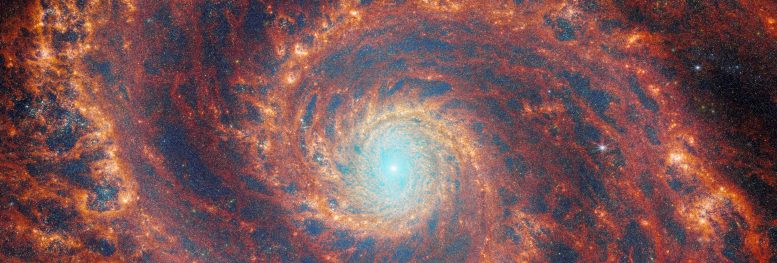
The James Webb Space Telescope has captured a striking image of the grand-design spiral galaxy M51, showcasing its well-developed arms. Situated 27 million light-years away from Earth, M51 has a unique relationship with the nearby dwarf galaxy NGC 5195, which is believed to influence its distinctive spiral arms. Credit: ESA/Webb, NASA & CSA, A. Adamo (Stockholm University) and the FEAST JWST team
The James Webb Space Telescope showcases the spiral galaxy M51’s grandeur, revealing its intricate relationship with the neighboring galaxy NGC 5195. Through the FEAST study, Webb deepens our understanding of star formation and the intricate processes within galaxies beyond the Milky Way.
The graceful winding arms of the grand-design spiral galaxy M51 stretch across this image from the NASA/ESA/CSA James Webb Space Telescope. Unlike the menagerie of weird and wonderful spiral galaxies with ragged or disrupted spiral arms, grand-design spiral galaxies boast prominent, well-developed spiral arms like the ones showcased in this image. This galactic portrait is a composite image that integrates data from Webb’s Near-InfraRed Camera (NIRCam) and the innovative Mid-InfraRed Instrument (MIRI), half of which was contributed by Europe.
The Colors and Patterns of M51
In this image, the dark red regions trace the filamentary warm dust permeating the medium of the galaxy. The red regions show the reprocessed light from complex molecules forming on dust grains, while colors of orange and yellow reveal the regions of ionized gas by the recently formed star clusters. Stellar feedback has a dramatic effect on the medium of the galaxy and creates a complex network of bright knots as well as cavernous black bubbles.
Galactic Neighbors: M51 and NGC 5195
M51 – also known as NGC 5194 or the Whirlpool Galaxy – lies about 27 million light-years away from Earth in the constellation Canes Venatici, and is trapped in a tumultuous relationship with its near neighbor, the dwarf galaxy NGC 5195. The interaction between these two galaxies has made these galactic neighbors one of the better-studied galaxy pairs in the night sky. The gravitational influence of M51’s smaller companion is thought to be partially responsible for the stately nature of the galaxy’s prominent and distinct spiral arms. If you would like to learn more about this squabbling pair of galactic neighbors, you can explore earlier observations of M51 by the NASA/ESA Hubble Space Telescope below.
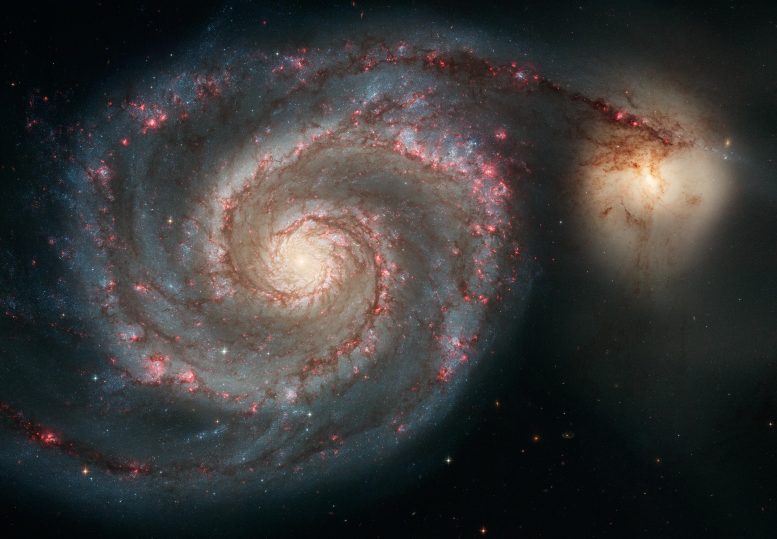
This sharpest-ever image, taken in January 2005 with the Advanced Camera for Surveys aboard the NASA/ESA Hubble Space Telescope, illustrates a spiral galaxy’s grand design, from its curving spiral arms, where young stars reside, to its yellowish central core, a home of older stars. The galaxy is nicknamed the Whirlpool because of its swirling structure. Credit: NASA, ESA, S. Beckwith (STScI), and The Hubble Heritage Team (STScI/AURA)
Project FEAST and Its Objectives
This Webb observation of M51 is one of a series of observations collectively titled Feedback in Emerging extrAgalactic Star clusTers, or FEAST. The FEAST observations were designed to shed light on the interplay between stellar feedback and star formation in environments outside of our own galaxy, the Milky Way. Stellar feedback is the term used to describe the outpouring of energy from stars into the environments which form them, and is a crucial process in determining the rates at which stars form. Understanding stellar feedback is vital to building accurate universal models of star formation.
A Deep Dive Into Star Formation
The aim of the FEAST observations is to discover and study stellar nurseries in galaxies beyond our own Milky Way. Before Webb became operative, other observatories such as the Atacama Large Millimetre Array in the Chilean desert and Hubble have given us a glimpse of star formation either at the onset (tracing the dense gas and dust clouds where stars will form) or after the stars have destroyed with their energy their natal gas and dust clouds.
Webb is opening a new window into the early stages of star formation and stellar light, as well as the energy reprocessing of gas and dust. Scientists are seeing star clusters emerging from their natal cloud in galaxies beyond our local group for the first time. They will also be able to measure how long it takes for these stars to pollute with newly formed metals and to clean out the gas (these time scales are different from galaxy to galaxy).
By studying these processes, we will better understand how the star formation cycle and metal enrichment are regulated within galaxies as well as what are the time scales for planets and brown dwarfs to form. Once dust and gas are removed from the newly formed stars, there is no material left to form planets.

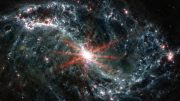
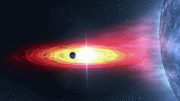
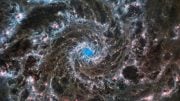

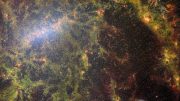
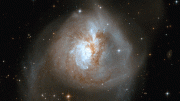

Be the first to comment on "Project FEAST: Webb Space Telescope Captures a Cosmic Whirlpool"